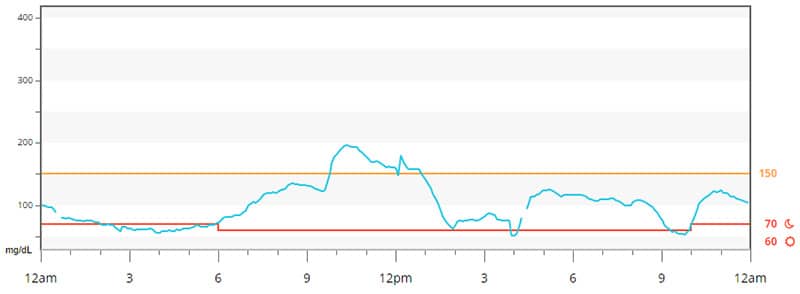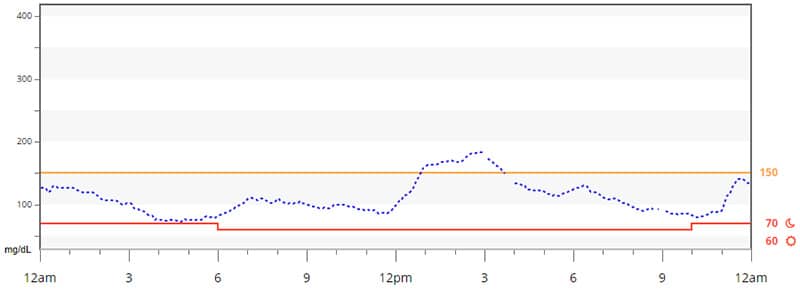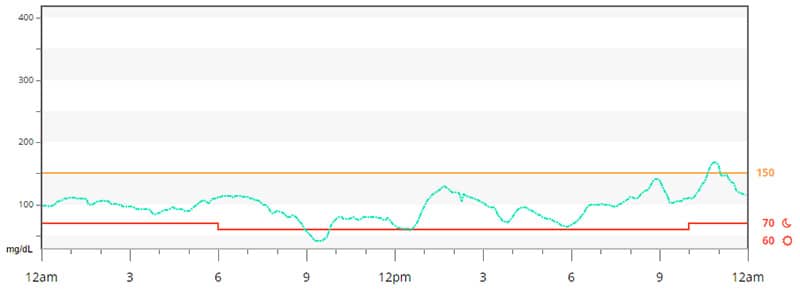I’ve been struggling with dawn phenomenon (high morning blood sugars) for the past few weeks. Because I have changed my fitness routine and diet recently (more carbs, heavy lifts to build muscles, and very little cardio), I have seen an overall increase in my basal needs, and mornings especially have been tricky to get right.
To figure out the best way to deal with my dawn phenomenon, I have experimented with different timings for my morning basal. Today I want to share the results with you, as I think they are quite interesting. It hasn’t been straightforward, so buckle up, I’m taking you for a ride.
Adjusting my basal insulin timing to avoid Dawn Phenomenon
I’m on MDI (multiple daily injections) and split my daily basal dose in two. One shot in the morning, and one at night. I don’t need as much insulin during the night, so splitting my dose helps me avoid fighting lows all night (assuming I take the right amount, of course).
As I mentioned earlier, my overall basal needs have increased recently, and settling on the right insulin dosage has been challenging. I’ve gone from taking 10 units total (7 units in the morning and 3 units at night) to 20 units (15 units in the morning and 5 units at night). That’s a pretty big jump for me, given that I’m still working out 6 days a week and eating clean.
Getting the daily dosage dialed in has taken me some time, as well as some trial and error, but to me, that was the easiest (although often most frustrating) part since I can always make corrections during the day if I need to.
What has been a real pain is dealing with dawn phenomenon. Since I wear a Dexcom CGM, I know exactly when it hits me. Every morning at 6 AM my blood sugars start to climb. That’s my hormones kicking in to get me ready for the day.
They are like: “HI! It’s 6 AM, time to get your day started so here’s some glucose to give you the energy to go out and kick butt!” That would be fine and dandy if it wasn’t for the fact that I don’t start my day until 8 AM. Tobias and I are more into working at night and sleeping in, so that’s how we’ve structured our workdays.
As you can see from the graph below, my blood sugar will spike like crazy even before I wake up if I don’t take my morning basal until 8 AM. I end up battling high sugars for hours, only to crash at around 2 PM. I don’t have to tell you how frustrating this is!


If I were on a pump, I would have set a higher basal rate for my mornings (this whole ordeal has almost made me consider pumping), but since I’m not, I’ve found that the only way I can counteract this increase is by setting an alarm to 6 AM, taking my basal then, and going back to bed.
This means interrupting my sleep, which isn’t that healthy, but on a good day, it will allow me to catch my dawn phenomenon before it really kicks in.


The downside to this approach (besides having to wake up at 6 AM) is that it will sometimes make my blood sugars drop too low at around 9 AM (before breakfast) like in the graph below.


So, tomorrow I’ll try setting the alarm to 7 AM to take my basal. I hope that I won’t see the insane increase in my blood sugars or the crash at 9 AM, but who knows?
My point with all of this is that if you want to really dial in your diabetes management, then taking very detailed notes and being prepared to do a lot of trial and error is the way to go. It’s hard to get right, but it can be done.
I would consider myself somewhat of a black belt in the diabetes trial and error department, but, as you can read here, even I struggle sometimes. So, if this all makes you uncomfortable, or if you need a second set of eyes on your data, I suggest working closely with your medical team.
Because not only are crazy blood sugars uncomfortable, annoying, and bad for your health, but they also mess with your fitness progress. And we can’t have that, can we? 😀
To learn more about the theory of dawn phenomenon and the “textbook” approach to dealing with it, you can read the guest post Managing Dawn Phenomenon with Basal Insulin by Gary Scheiner, MS, CDE

